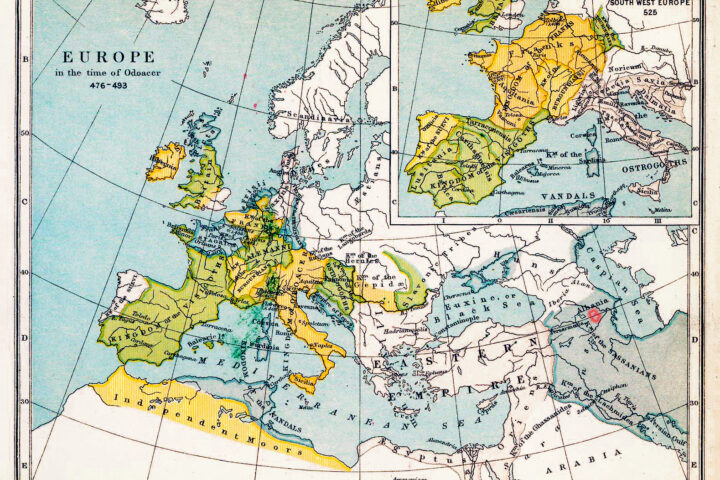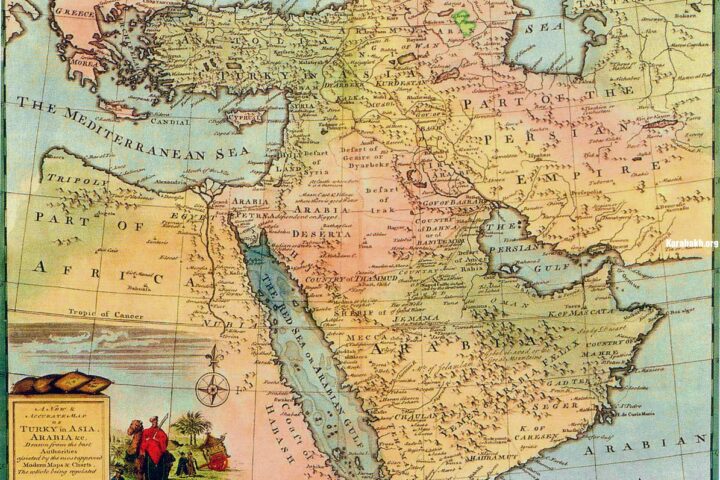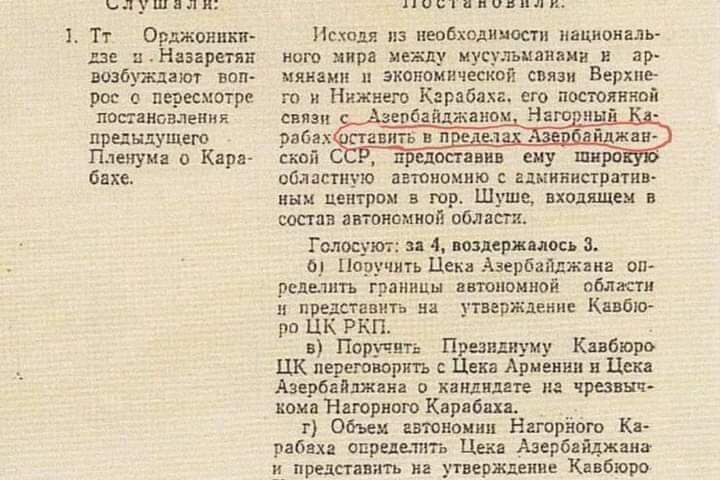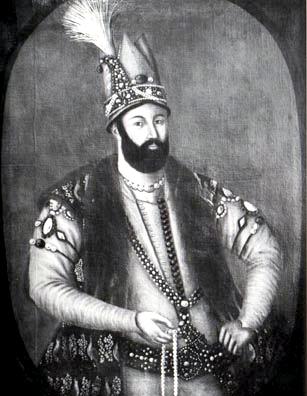In the mountainous part of Karabakh khanate, there were small feudal entities – melikdoms: Khachen, Varanda, Talish (or Gulistan), Dizak and Jeraberd, which completely depended on Karabakh khans and did not play an independent role in history.
There were five melikdoms, which is why they were called “khamsa” (“five” in Arabic). The meliks of Karabakh were assimilated Caucasian Albanians. It is not without a reason that not a single surname of Karabakh meliks hailed from Armenian families. Moreover, they had Muslim names. These were local feudal rulers whose ancestors were armenianized after the Albanian Church was placed under the jurisdiction of the Armenian Church in the 8th century on orders from Arab Caliph abd-al-Malik. [ref]Z.M.Bunyadov, Essays, Volume 1, Baku, 1999, chapter 3, § 2[/ref]
For this reason, all surnames beginning from “melik” are Albanian, while their bearers are Albanians some of whom armenianized and most of whom converted to Islam and joined the Azerbaijani people. Such family names are Melik-Yeganov, Melik-Pashayev, Melik-Aslanov, Melik-Shahnazarov and others. Such a metamorphosis also happened to some Georgian and Armenian family names: Orbeli and Bagratov.
Melik is a term of Arabic origin and initially implied “king”. Among these melikdoms, only one, Khachen, had historical roots on the land of Karabakh. In the 13th century, a representative of the Mihranid family, Hasan Jalal, restored the power of the Artsakh-Khachen principality in a region of ancient Albania [ref]I.A.Orbeli, Hasan-Jalal the Prince of Khachen, Selected Works, Yerevan, 1963, p. 146[/ref].
According to the Armenian historian, P. Arutyunyan: “The rulers of the Khachen region were the major feudal rulers Hasan-Jalalyans. Having built the Gandzasar monastery in 1240, they took secular and spiritual power in this region, keeping both up to the 19th century” [ref]P. T. Arutyunyan. The liberation movement of the Armenian people in the first quarter of the 18th century. Moscow, 1954, p.60[/ref]. Being a direct descendant of the Caucasian Albanians, the ruler of the Khachen principality, Hasan Jalal, was regarded not only as “an autocratic prince of princes, ruler of Khachen” and “the prince of Khachen and Aran”, but also “great ruler of Albania” and “king of Albania”.
The Albanian roots of the Khachen meliks also proved by the fact that not a single source mentions the population of Khachen as Armenian. The “Khachen Armenians” themselves always call themselves “Agvans” in historical documents (i.e. Albanians). This is evidenced by their message to Peter I in 1722, as well as by the work of the catholicos of the Gandzasar Monastery, Yesai Hasan-Jalalyan, who called the land where his ancestors lived “Agvan” and his work – “a Brief History of the Agvan Country” [ref]Yesai Hasan-Jalalyan, A Brief History of the Agvan Country (1702–1722), Baku, 1989[/ref].
The Varanda, Talish and Jeraberd melikdoms emerged on the territory of Karabakh only in the 17th century and Dizak – in the early 18th century. They were formed by descendants of noble Albanian families who migrated here. For example, concerning the Varanda melikdom, Mirza Adigozal-bey recorded that the rulers of Varanda were “Melik-Shahnazarli – noble people of the Goyja (Goycha) area which they fled, arrived in Karabakh and became intoxicated with their melik rule in the Varanda mahal” [ref]Mirza Adigozal-bey. Karabakh-nameh. Baku, 1950, p. 57[/ref]. in the middle of the 18th century, power in Varanda was seized by Melik Shahnazar who killed his brother, a legitimate melik. [ref]A. R. Ioannisyan, Russia and the Armenian liberation movement in the 1780s, Yerevan, 1947, p. 16[/ref]
Concerning the Talish (Gulistan) melikdom, they note: “according to popular legend, the founder of the Gulistan melikdom – the Melik-Beklaryans – was a certain ‘gara-yuzbashi’ Abov who moved from the Udin village of Nizh to the village of Talish together with his people in the early 17th century” [ref]P. T. Arutyunyan, ibid., p. 60[/ref]. The village of Nizh (Gabala District) still exists in Azerbaijan. its residents – one of the 26 Albanian tribes – are Udins who maintain their language, Christian religion and material and spiritual culture [ref]G. D. Javadov, R. A. Huseynov, A historical-ethnographic essay, Baku, 1999 (in Azerbaijani)[/ref].
Concerning the Talish melikdom, one document says that its founders moved to Karabakh from Shirvan [ref]Yerevan Matenadaran, manuscript No 4463, p. 7.[/ref] Concerning the Talish melikdom, Mirza Adigozal-bey recorded: “Its melik was Melik-Usub. The ancestors of this melik hailed from Shirvan. They lived in the village of Talish for some time. Many people from this family repeatedly became meliks. Subsequently, Melik-Usub seized Gulistan Castle and settled there” [ref]Mirza Adigozal-bey, ibid., p. 58[/ref]. Therefore, the Talish melikdom is also often called Gulistan in sources.
Concerning the Jeraberd melik, P. T. Arutyunyan noted in his work that “the forefather of the rulers of the Charaberd melikdom was the son of melik-Israel, melik-Yesai, who killed the Syuni khan and moved to Karabakh together with his subjects in 1678. After the death of Yesai, the melikdom was taken over by melik-Allakuli-Sultan and his brother” [ref]P. T. Arutyunyan, ibid., p. 61[/ref]. The source notes that they moved to the Charaberd county and Jermuk Castle from Magavuz [ref]Yerevan Matenadaran, manuscript No 4463, p. 7.[/ref]
Mirza Adigozal-bey recorded in this regard: “The melik of this mahal was Melik-Allah-Guli. His family came here from Magaviz (Magavuz – a village in Zangazur) and they became meliks and settled in an inaccessible and impassable place called Jermykh (short for Jeraberd) on the Tartar River. Having chosen Jermykh Castle as their sanctuary, they took over the Chilaburd area (Jeraberd) and became its independent rulers where they gained fame” [ref]Mirza Adigozal-bey, ibid., pp. 57–58[/ref].
The source says that the forefather of the Dizak melik “was melik-Yegan, the son of Gukas (Movses)-Vardapet. According to a number of sources, the family of melik-Yegan moved to Karabakh in the early 18th century: according to some information, they moved to Dizak from Persia and according to other sources, from Lori (Georgia) ” [ref]P. T. Arutyunyan, ibid., p. 61[/ref]. Mirza Adigozal-bey wrote more clearly about the Dizak mahal: “The meliks of this mahal were called Melik-Yegans. These were refugees from Lori. They received the title of meliks under Nadir-shah and according to his decree, took the throne of the melikdom” [ref]Mirza Adigozal-bey, ibid., p. 57[/ref].
By the middle of the 18th century, the Karabakh meliks enjoyed the rights of feudal rulers. They had their own armed detachments. However, their power did not go beyond the melikdom. They were all vassals of the Karabakh khan. The title “melik” was characteristic not only of Albanian feudal rulers of Nagorno-Karabakh. They were known in the history of Azerbaijan in the 13th–15th centuries. The title “melik”, Azerbaijani historians point out, was held by separate Azerbaijani feudal rulers in both Karabakh and Shirvan [ref]G. Abdullayev, ibid., p. 156[/ref]. Major feudal rulers of Sheki were also meliks. The meliks of Gutgashen mahal were rich landowners [ref]Yesai Hasan-Jalalyan, ibid., pp.24–26[/ref].
In the fight to strengthen the khan’s power in Karabakh, the capital of the khanate was moved three times. The first residency of the khan became Fort Bayat, which was built in 1748. “In a short period, the external walls were erected, ditches were dug and a market, bath and mosque were built.” Craftsmen from outskirts were resettled to the fort. “[apart from them], many residents of neighboring areas and even resi- dents and especially, craftsmen of the Tabriz vilayet and Ardabil, who heard about the success, politeness and mercy of Panah Khan, also came with their families and settled in Fort Bayat” [ref]Mirza Jamal Javanshir, ibid., p. 68[/ref].
The strengthening of the power of Panah Ali-khan met with resistance from several other Azerbaijan khans. In 1748, the Karabakh khan started a fight against Sheki khan Haji Chelebi-khan, one of the strongest feudal rulers of Azerbaijan. Trying to prevent the strengthening of Panah Ali-khan, Haji Chelebi-khan and his ally – the khan of Shamakhi, besieged Fort Bayat. The allies unsuccessfully tried to seize the centre of the Karabakh khanate for a month. Failing to achieve success and sustaining great losses, the Sheki and Shirvan khans retreated. Haji Chelebi-khan was forced to admit: “Panah-khan was like uncoined silver. We came here, coined it (silver) and went back” [ref]Mirza Adigozal-bey, ibid., p. 54[/ref].
The establishment of an independent Karabakh khanate on the vast territory of the former Karabakh beylerbeydom in the 18th century and the fortification of Fort Bayat by Panah Ali-khan strongly alarmed the meliks who did not want to lose their power and privileges granted by Nadir-shah. A fight began between the Karabakh khan and meliks, and it had a political rather than religious nature. It was a feud typical of feudalism. The melik of Varanda, Shahnazar, was the first to recognize the power of the Karabakh khan. He married his daughter to the son and heir of Karabakh Khan ibrahim Khalil-aga [ref]Mirza Adigozal-bey, ibid., p. 59[/ref]. Thus, Varanda broke away from the “khamsa” and finally fell under the patronage of the khan, becoming his vassal and true stronghold in the future. Panah ali-khan encountered strong resistance from residents of the Khachen melikdom. “The fire of battle and fighting raged for three days. On the third day, Panah khan took their fortification” [ref]Mirza Jamal Javanshir, ibid., p. 69[/ref].
Having suffered a defeat and lost up to 300 men, the Khachen melik surrendered to the mercy of the victor. In honour of this victory, Panah Ali-khan erected a monument at the site of the battle [ref]Mirza Jamal Javanshir, ibid., p. 120[/ref]. Having subjugated the Khachen melik, Panah Ali-khan allowed him to mint the khan’s coin – the Panabad.
Having realized that the battle was lost, the Jeraberd melik Allahguli-Sultan also laid down his weapons and signed a peace treaty [ref]Mirza Jamal Javanshir, ibid., pp. 120–121[/ref]. However, the peaceful relations between the Karabakh khan and the Jeraberd melik did not last long. The melik of Varanda, Shahnazar, who “had long been hostile to Allah-Guli-Sultan”, persuaded Panah Ali-khan to sever relations with the Jeraberd melik. As a result, on orders from the Karabakh khan, the Jeraberd melik Allah-Guli-Sultan was captured and executed [ref]Mirza Jamal Javanshir, ibid., p. [/ref] Panah Ali-khan appointed his brother – melik Khatam – melik of the Jeraberd mahal [ref]Mirza Adigozal-bey, ibid., p. 59[/ref]. Despite his appointment, melik Khatam soon allied himself with the melik of Talish against Panah Ali-khan.
These meliks refused to recognize the power of the Karabakh khan for several years. Panah Ali-khan launched several military campaigns against the intractable meliks. However, due to the impregnability of Jeraberd Castle, the rebellious meliks managed to repel all attacks. Only after Panah Ali-khan destroyed all crops in the county and blockaded Jeraberd Castle, were the besieged meliks forced to flee to Ganja. “They lived in the Ganja vilayet and Shamkur mahal for seven years” [ref]Mirza Jamal Javanshir, ibid., p. 69[/ref].
The Karabakh khan’s fight against the melik of Dizak also dragged on. Melik Isai resettled most of his population to the fortified village of Tuk where Dizak’s armed detachments of up to 3,000 people were based. Bloody clashes, accompanied by colossal casualties, occurred between the sides. Panah Ali-khan, wounded in one of them, was forced to retreat. Only a new attack on melik Isai’s fortification was successful for Panah Ali-khan.
The defeated melik of Dizak, “on seeing his situation, especially the lack of food and losing all hope to get any help, decided to ask for peace” [ref]Mirza Jamal Javanshir, ibid., p. 123[/ref]. On orders from Panah Ali-khan, melik Isai was deprived of his property and resettled to Fort Shusha together with his family. other security measures were taken too. Specifically, all residents of the village of Tuk were forcibly resettled by the Karabakh khan to other parts of the khanate. Thus, in the 1750s the Karabakh ruler Panah Ali-khan managed to break the resistance of local feudal rulers, the “khamsa” meliks, and subjugate them in a fierce and brutal feud.
The melikdoms became vassals, for nothing could stop the establishment of strong khan rule in Karabakh and the submission of small feudalists to the suzerain of this part of Azerbaijani soil.







